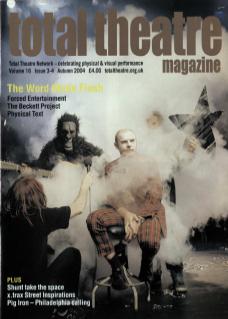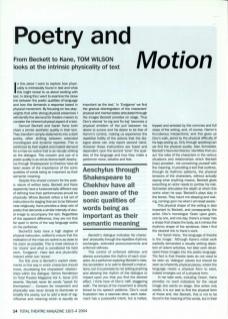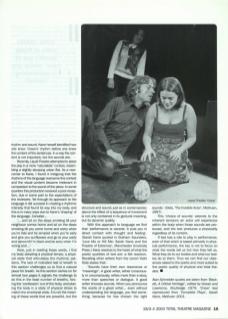In this piece I want to explore how physicality is intrinsically found in text and what this might reveal to us about working with text. In doing this I want to examine the close link between the poetic qualities of language and how this demands a response based in physical movement. By focusing on two playwrights that write strong physical presences I will identify the demand for theatre-makers to consider the inherent physical aspect of a text.
Samuel Beckett and Sarah Kane both share a similar aesthetic quality in their text. They transform simple statements into a dark poetry, often shifting between extended monologues and dynamic repartee. This is reinforced by their explicit and implicit demand for a mise en scène that is as visually striking as the dialogue. This concern and use of a poetic quality is as old as drama itself; Aeschylus through Shakespeare to Chekhov have all been aware of the importance of the sonic qualities of words being as important as their semantic meaning.
Despite this shared concern for the poetic nature of written texts, Beckett and Kane apparently have a fundamentally different way of defining how their performances should be physically. Where Beckett writes a full set of instructions for staging that are to be followed near religiously, Kane provides a deep vein of poetry that demands a similar intensity of visual image to accompany the text. Regardless of this apparent difference, they are not that far apart in terms of the way language works on the performer.
Beckett's texts have a high degree of physical instruction, crafted to ensure that the realisation of the mise en scène is as close to his vision as possible. This is most obvious in his 'shorts' and what is considered his best work, Endgame. Here text and physicality interact within two 'zones'.
The first zone is Beckett's explicit statements on the way in which characters should move, elucidating the characters' relationships within the dialogue. Simon Henderson (in Total Theatre Magazine Vol 4, Issue 2/3) asserts: 'Beckett never let words "speak for themselves"... Concern for movement and physicality was never simply to illuminate or amplify the poetry, but to add a level of significance and meaning which is equally as important as the text.' In Endgame we find the gradual disintegration of the characters' physical and mental states articulated through the images Beckett provides on stage. Thus Clov's eternal 'to-ing and fro-ing' becomes a physical emblem of the pull between his desire to survive and his desire to be free of Hamm's control, making us experience the repetitive futility of the actions that the dialogue alone can only report second hand. However, these instructions are fused and dependent upon the second ‘zone': the qualities of the language and how they make a performer move, breathe and feel.
Beckett's dialogue indicates his characters' physicality through the repetitive rhythmic exchanges, extended pronouncements and enforced stillness.
This control of enforced stillness and silence punctuates the rhythm of each character. As a performer exploring Beckett's roles, the temptation is to add to Beckett's instructions, but it is precisely by not adding anything and allowing the rhythm of the dialogue to impact upon you that you find the desired effect. I think here of Clov's ‘stiff, staggering walk'. The tempo of his movement is directly linked to his speech patterns. Clov's vocal frustration has a staccato drive, each statement has a purposeful intent, but is halted, tripped and arrested by the commas and full stops of the writing, and, of course, Hamm's thunderous interjections; and this gives us Clov's walk, jarred by the physical difficulty of his legs seizing up. Only through speaking can we find the physical quality. Alan Schneider, Beckett's favoured director, identifies that you act 'the roles of the characters in the various situations and relationships which Beckett [has] provided', not concerning yourself with the meaning. In providing a text that outlines, through its rhythmic patterns, the physical tensions of the characters, without actually saying what anything means, Beckett gives everything an actor needs to portray his role. Schneider articulates the depth at which this works when he says 'Beckett's plays stay in the bones. They haunt me sleeping and waking, coming upon me when I am least aware.’
This physical shape of the writing is also important to Beckett, and consequently the actor. Clov's monologue ‘Grain upon grain, one by one, and one day, there's a heap’ has a shape that shapes the body, as it mimics the rhythmic shape of the sentence. Here I find the clearest link to Kane's work.
For Sarah Kane, 'the language of theatre is the image’. Although Kane's initial work explicitly demanded a visually striking depiction of violent activities, her later work developed these images into the poetic language. The fact is that theatre texts do not need to be seen as 'dialogue’ pieces but should be seen as inherently physical pieces, where the language needs a physical form to exist, indeed emerges out of a physical form.
In her later work, including Crave, Kane provides no overt indicators for the visual image she wants on stage. She writes only words; it is our task to find the physical form of these and, like Beckett, this is not to be found in the meaning of the words, but in their rhythm and sound. Kane herself identified how she knew Crave's rhythm before she knew the content of the sentences. In a way the content is not important, but the sounds are.
Recently, Liquid Theatre attempted to place the play in a more 'naturalistic' context, resembling a slightly decaying urban flat. As a newcomer to Kane, I found it intriguing that the rhythms of the language overcame this context and the visual content became irrelevant in comparison to the sound of the piece. In some quarters this production received a poor reception, due in some part to the expectations of the reviewers. Yet through its approach to the language it did succeed in creating a rhythmic intensity that found its way into my body, and this is in many ways due to Kane's 'shaping; of the language. Consider...
‘... and sit on the steps smoking till your neighbour comes home and sit on the steps smoking till you come home and worry when you're late and be amazed when you're early and give you sunflowers and go to your party and dance till I'm black and be sorry when I'm wrong and...'
Here, just in reading these words, I find my body adopting a physical tempo, a physical state that articulates the rhythmic patterns. The lack of indicated rest or breath in this section challenges us to find a natural place for breath. As this section carries on for almost two pages it signals the challenge to do this in the least number of breaths, forcing the 'confession' out of the body, and placing the body in a state of physical stress to match the emotional crisis. It is not the meaning of these words that is powerful, but the structure and sound, just as in contemporary dance the effect of a sequence of movement is not only contained in its gestural meaning, but its dynamic quality.
With this approach to language we find that 'performance is visceral. It puts you in direct contact with thought and feeling’ (Sarah Kane quoted in Graham Saunders, Love Me or Kill Me: Sarah Kane and the Theatre of Extremes, Manchester University Press.) Kane reaches to the heart of what the poetic qualities of text are: a felt reaction. Recalling other writers from the canon Yoshi Oida states that:
‘Sounds have their own resonance or "meanings". A good writer, either consciously or unconsciously, writes more than a story, more than speeches or dialogue. A good writer chooses sounds. When you pronounce the words of a great writer... even without understanding the language, you feel something, because he has chosen the right sounds.' (Oida, The Invisible Actor. Methuen, 1997)
This 'choice of sounds' extends to the inherent tensions an actor will experience within the body when those sounds are produced, and the text produces a physicality regardless of its content.
If text has a role to play in performance, even of that which is based primarily in physical performance, the key is not to focus on what the words tell us but how they tell us. What they do to our bodies and what our bodies do to them. Thus we can find our utterances raised to the poetic and more suited to the poetic quality of physical and total theatre.
Alan Schneider quotes are taken from Beckett, A Critical Heritage, edited by Graver and Lawrence, Routledge 1979. Crave text reproduced from Complete Plays, Sarah Kane, Methuen 2001.


